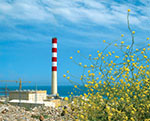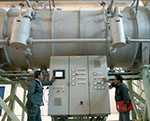Crete powers on
The Atherinolakkos power plant on the remote south-east coast of Crete is seen by Greece’s Public Power Corporation as a key part of its solution to ensure that the busy holiday island’s growing energy needs will be met in years to come.
DATE 2023-11-28 AUTHOR Philip Pangalos Most people have heard of the beautiful holiday island of Crete, with its rich history, magnificent villages and idyllic beaches, and many may have even been lucky enough to have enjoyed a vacation there at some time.
Most people have heard of the beautiful holiday island of Crete, with its rich history, magnificent villages and idyllic beaches, and many may have even been lucky enough to have enjoyed a vacation there at some time.
The island of Crete with an area of 8 260 square km is Greece’s largest. As well as being a thriving tourist destination and host to millions of visitors every year, it is self-sufficient with booming service, commercial and agricultural centres.
Cretans are famed for their healthy Mediterranean diet which includes plenty of locally produced fruit and vegetables as well as olive oil from the island’s abundant olive groves. That’s why such importance has been placed on ensuring economic growth and prosperity while at the same time safeguarding the environment of this key tourist destination.
Being among the sunniest spots in Europe is an advantage and Crete’s booming tourist industry has helped to fuel the local economy and benefit the island’s 600 000 local inhabitants.
Growing energy needs
This infrastructure needs a steady and dependable power supply to sustain and ensure its continued growth. As a consequence, local residents and hundreds of hotels place increasing demands on the Public Power Corporation S.A. (PPC S.A.), the country’s main electric energy provider, for their power needs.
The supply network can be heavily loaded in the busy summer season as consumption increases. This is especially the case during a heat wave when thousands of air conditioning units are turned on. Naturally, power cuts must be avoided if adequate support to the tourist industry is to be maintained.
Crete is the Mediterranean’s fourth largest island and has sought new solutions to meet its energy demands. PPC S.A., which is the main organization for power generation in Greece, has invested in Crete’s Atherino-lakkos power plant. This is where Alfa Laval also plays a key role as the supplier of the desalination technology, i.e. equipment for turning seawater into fresh water by removing salts.
Crete’s energy needs show the highest percentage growth rates in Greece. These needs, boosted by tourism, can show an annual growth of no less than 8%.
“In the past, Crete had two main power generating plants,” said Michael Brokakis, the Atherinolakkos Plant Operations Supervisor. “Over the last 10 years, the existing power stations have been expanded in order to meet the increased needs. But there were limitations, including the need to have any new power production facilities far away from existing tourist or urban areas. The area chosen was suitable for the expansion of Crete’s power generation for technical, geographic and environmental reasons since it did not adversely affect development on the rest of the island.”
Strict environmental standards
Environmental and safety issues are a top priority for PPC S.A. and its power plants. The Atherinolakkos plant takes advantage of the latest technological advancements for maximum control. All flue gas emissions and treated effluents discharged from the plant comply with existing European legislation requirements.
 “We have covered ourselves against any potential accidental pollution by fulfilling all today’s strict environmental standards and legislative requirements,” Mr. Brokakis stressed.
“We have covered ourselves against any potential accidental pollution by fulfilling all today’s strict environmental standards and legislative requirements,” Mr. Brokakis stressed.
In the next decade the Atherinolakkos power station is expected to be the biggest power provider for Crete, once the third phase of expansion proceeds. This will depend on future needs, and may be able to meet about one-third of the island’s growing energy requirements.
Apart from other older power generation plants elsewhere on the island, small, privately-operated wind power generators also provide energy for the island. However, although wind energy is an environmentally friendly power source it is also unpredictable as nobody knows when or how long the wind will blow nor how strong it will be.
Public Power Corporation S.A. buys power from the privately-run wind energy producers, helping to top-up the island’s energy needs while at the same time reinforcing its priority on the environment.
Far away from tourist areas
“Construction work at the Atherinolakkos power plant site, including support infrastructure and the adjoining harbour allowing access to ships, began in January 2001,” said Paul Leoussis, Chemical Engineer at the Thermal Power Plants Project.
“There were just mountains before we started. There was nothing else, no roads, and the nearest village was 10 km away,” added Konstantinos Gomozias, member of the PPC’s Thermal Power Plants Project Department whose office oversees the Atherinolakkos site.
“We have been operating commercially since 2004 by supplying the local grid with 102 MW,” Mr Leoussis said. “We have two 51 MW diesel engine units burning heavy fuel oil with low sulphur, minimizing environmental impact.”
Once the next second phase is completed, the Atherinolakkos power plant will be capable of producing a further 100 MW from conventional steam units burning the same kind of fuel. All units have the capacity to burn natural gas if this fuel becomes available in Crete with the construction of a LNG (liquefied natural gas) terminal. At present, there are two 22 000 tonne heavy fuel oil storage tanks at Atherinolakkos which more than satisfy the plant’s current needs.
Once it is at full capacity, possibly before the end if this decade, Atherinolakkos will be able to produce more than 400 MW, with the additional help of diesel engine units. The plant will be able to take over some of the power generation burdens from other older Public Power Corporation plants elsewhere on the island.
Crete’s energy needs vary depending on the time of year and are significantly affected by the busy summer holiday season when the island is often teeming with visitors. “It wasn’t just an issue of how not to disturb the physical landscape, but we also wanted to protect the environment by minimizing possible pollutants on nearby Cretans,” said Mr Leoussis, explaining that the environment and the best interests of the island and its residents have always been a priority for PPC S.A.
“The air pollutants from the chimney stack, which has been built so tall (125m) after specific studies and taking into account the northern winds that blow here, will not have an effect on the locals,” he added.
Capacity for future needs
The Atherinolakkos power station’s distant location may have suited the environmental needs and limit any potential impact on Crete’s tourism, but it also meant that PPC S.A. had to overcome the problem of where to find water of the quality standard required for power generation.
“Much depends on the quality and quantity of water you have to start with,” said Mr Brokakis. He stressed that water was clearly not in abundance in the remote Atherinolakkos area.
“The units we have to produce energy need a quantity of desalinated water of a particular high quality” said Mr. Leoussis. “At the moment we have two desalination units, each with a capacity of 30 cubic metres per hour. One is on standby to ensure availability when needed. This level of redundancy is part of PPC’s strategy.”
“Our needs at present are of course lower and the desalination systems are not operating at full capacity. However, the systems will be fully used in the next phase of Atherinolakkos, Atherinolakkos 2, where the needs will be much greater due to a different power generating procedure,” Mr Leoussis said. “For Atherinolakkos 2 we will use steam generators, whereas this plant has diesel engines.”
Mr Brokakis added that newer technologies being implemented in PPC’s power generation processes mean that emission levels are falling with future benefits for the environment as well as the customer as a consequence.
Alfa Laval / Atherinolakkos cooperation
Two Alfa Laval desalination plants were installed in the Atherinolakkos Power Station last September for the production of 1440 cubic metres of distilled water per day for internal and external use.
Many local and foreign contractors had participated in the tender process. Alfa Laval was one of those submitting bids to the turnkey contractor – the consortium of BWSC-Athena S.A.-Mitsui. PPC and the consortium agreed that the plate desalination system from Alfa Laval fulfilled the requirements described in the Technical Specification of the contract.
Alfa Laval’s solution is based on the Multiple Effect Distillation technology with vapour recompression using plate heat exchangers that allow a thin and even film of water to pass over the evaporation heat transfer surfaces. The use of plate heat exchangers results in high heat transfer coefficients, good control of seawater distribution on the heat transfer surface and, since the plates are pressed in titanium, exceptional corrosion resistance. Since the system enables recycling of part of the vapour it has a particularly high performance ratio.“
I find the equipment supplied by Alfa Laval to be reliable, both in terms of its operation and in the result,” said PPC’s Despina Emanioulidou, the person responsible for water and waste water treatment at the Atherinolakkos plant. “We have excellent operating results,” she added.“
This desalination plant is complex but totally automated,” said Takis Kalokerinos, Manager of Alfa Laval’s Marine & Diesel Equipment in Greece. “The unit also has the advantage of having sea water corrosion-resistant titanium plates, which together with the plant’s design helps to avoid the permanent build-up of calcium.
